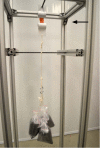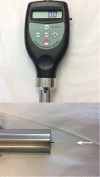Glenohumeral joint capsular tissue tension loading correlates moderately with shear wave elastography: a cadaveric investigation
- PMID: 31786904
- PMCID: PMC7065991
- DOI: 10.14366/usg.19032
Glenohumeral joint capsular tissue tension loading correlates moderately with shear wave elastography: a cadaveric investigation
Abstract
Purpose: The purpose of this study was to investigate changes in the mechanical properties of capsular tissue using shear wave elastography (SWE) and a durometer under various tensile loads, and to explore the reliability and correlation of SWE and durometer measurements to evaluate whether SWE technology could be used to assess tissue changes during capsule tensile loading.
Methods: The inferior glenohumeral joint capsule was harvested from 10 fresh human cadaveric specimens. Tensile loading was applied to the capsular tissue using 1-, 3-, 5-, and 8-kg weights. Blinded investigators measured tissue stiffness and hardness during loading using SWE and a durometer, respectively. Intraobserver reliability was established for SWE and durometer measurements using intraclass correlation coefficients (ICCs). The Pearson product-moment correlation was used to assess the associations between SWE and durometer measurements.
Results: The ICC3,5 for durometer measurements was 0.90 (95% confidence interval [CI], 0.79 to 0.96; P<0.001) and 0.95 (95% CI, 0.88 to 0.98; P<0.001) for SWE measurements. The Pearson correlation coefficient values for 1-, 3-, and 5-kg weights were 0.56 (P=0.095), 0.36 (P=0.313), and -0.56 (P=0.089), respectively. When the 1- and 3-kg weights were combined, the ICC3,5 was 0.72 (P<0.001), and it was 0.62 (P<0.001) when the 1-, 3-, and 5-kg weights were combined. The 8-kg measurements were severely limited due to SWE measurement saturation of the tissue samples.
Conclusion: This study suggests that SWE is reliable for measuring capsular tissue stiffness changes in vitro at lower loads (1 and 3 kg) and provides a baseline for the non-invasive evaluation of effects of joint loading and mobilization on capsular tissues in vivo.
Keywords: Elasticity; Elastography; Hardness; Joint capsule; Reliability.
Conflict of interest statement
No potential conflict of interest relevant to this article was reported.
Figures




Similar articles
-
Model for liver hardness using two-dimensional shear wave elastography, durometer, and preoperative biomarkers.World J Gastrointest Surg. 2021 Feb 27;13(2):127-140. doi: 10.4240/wjgs.v13.i2.127. World J Gastrointest Surg. 2021. PMID: 33643533 Free PMC article.
-
Relationship between shear modulus and passive tension of the posterior shoulder capsule using ultrasound shear wave elastography: A cadaveric study.J Biomech. 2020 Jan 23;99:109498. doi: 10.1016/j.jbiomech.2019.109498. Epub 2019 Nov 9. J Biomech. 2020. PMID: 31735360
-
Shear wave elastography for liver stiffness measurement in clinical sonographic examinations: evaluation of intraobserver reproducibility, technical failure, and unreliable stiffness measurements.J Ultrasound Med. 2014 Mar;33(3):437-47. doi: 10.7863/ultra.33.3.437. J Ultrasound Med. 2014. PMID: 24567455
-
Technical Performance of Two-Dimensional Shear Wave Elastography for Measuring Liver Stiffness: A Systematic Review and Meta-Analysis.Korean J Radiol. 2019 Jun;20(6):880-893. doi: 10.3348/kjr.2018.0812. Korean J Radiol. 2019. PMID: 31132814 Free PMC article.
-
Shear Wave Elastography as a Quantitative Biomarker of Clinically Significant Portal Hypertension: A Systematic Review and Meta-Analysis.AJR Am J Roentgenol. 2018 May;210(5):W185-W195. doi: 10.2214/AJR.17.18367. Epub 2018 Mar 23. AJR Am J Roentgenol. 2018. PMID: 29570374
Cited by
-
Evaluation of the ulnar nerve with shear-wave elastography: a potential sonographic method for the diagnosis of ulnar neuropathy.Ultrasonography. 2021 Jul;40(3):349-356. doi: 10.14366/usg.20101. Epub 2020 Aug 23. Ultrasonography. 2021. PMID: 33115185 Free PMC article.
-
Investigating the Reliability of Shore Hardness in the Design of Procedural Task Trainers.Bioengineering (Basel). 2025 Jan 7;12(1):41. doi: 10.3390/bioengineering12010041. Bioengineering (Basel). 2025. PMID: 39851315 Free PMC article.
References
-
- Luime JJ, Koes BW, Hendriksen IJ, Burdorf A, Verhagen AP, Miedema HS, et al. Prevalence and incidence of shoulder pain in the general population; a systematic review. Scand J Rheumatol. 2004;33:73–81. - PubMed
-
- Menge TJ, Boykin RE, Byram IR, Bushnell BD. A comprehensive approach to glenohumeral arthritis. South Med J. 2014;107:567–573. - PubMed
LinkOut - more resources
Full Text Sources

